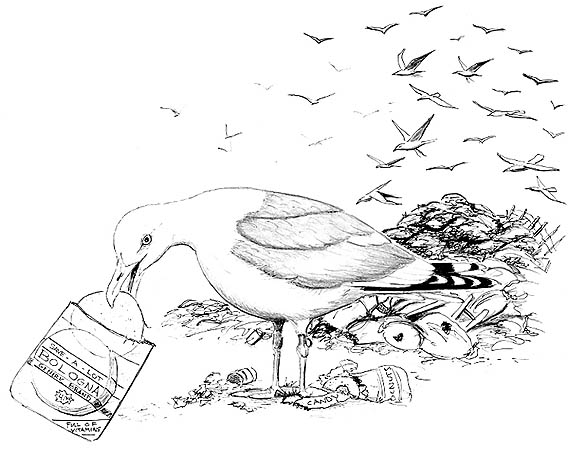
Last Week:
For any of you who care to remember, a guy named, David, from Vestal, NY, wrote in to ask why he didn’t see as many gulls in Provincetown during his July visit as he did in January. He wondered if the closing of the landfills had caused a drastic drop in the Herring Gull population. I explained that Provincetown is so filled with colorful characters in July that there is little room for gulls or any other creature that can’t afford to pay for parking. I also mentioned that during the warm weather most of the adult gulls move to Monomoy National Wildlife Refuge, where they happily go about their annual baby making duties. However, I ran out of room before I was able to answer the part about the Herring Gull/landfill relationship. And because I wasn’t able to finish answering, many of you haven’t slept all week wondering about this very interesting topic. Well, read on and you’ll be asleep in no time.
The gull/landfill relationship seems like a match made in heaven. We want to get rid of our slimy garbage and the gulls are very willing to take it off our hands. But, like most relationships, this one has a few problems. Depending on who you talk to, our trash has either caused the Herring Gull population to explode or it has actually negatively impacted their population. But one thing is clear. After years of eating mounds of our stinky garbage, Herring Gulls have the worst breath in the entire avian world, which has caused them have a lifelong addiction to Mentos.
No one really knows how many Herring Gulls were around when the first Europeans arrived in New England. Apparently, the early settlers were so busy trying to stay alive that they had little time to do a proper gull census. One thing that’s certain is that whatever Herring Gulls were around were often persecuted for their eggs and feathers or used to make the pioneer specialty, gull-kabobs. By the time J.J. Audubon arrived on the scene the Herring Gull was considered to be a rare bird. The Migratory Species Act protected the gulls, along with many other birds. With gull kabobs no longer on the menu, the gull population made an instant comeback.
In the early part of the twentieth century there were only 8,000 pairs of Herring Gulls in the United States and all of those were nesting in Maine. Ninety years later the birds had expanded their nesting colonies down the Atlantic Coast, as far south as Virginia, with breeding pairs exceeding 100,000. This made for an interesting irony. Typically, when a bird’s population drops it’s the nature freaks who sound the alarm, and that’s what they did to save the Herring Gull. But then, several decades later, it was the nature freaks who once again complained when the gull population soared to record high numbers. Boy, some people are never happy.
In case you hadn’t noticed, Herring Gulls are large birds. They are in fact larger than most of our hawks. Because of their large size very few birds are able to push Herring Gulls around. Most birds just get out of their way, or are eaten. This size discrepancy really became a factor on the breeding grounds. Puffins, terns and smaller gulls, were often pushed out of their traditional nesting areas because of the expanding Herring Gull population. What’s the old saying: 8,000 are company, 100,000 are a crowd?
While some debated about what to do with the extra gulls, others argued about how we ended up with so many in the first place. Many, of course, pointed to the bounty at the landfills. As a society we throw away just about anything, which is perfect for a bird that eats just about anything. However, some studies suggest that the dumps aren’t always as beneficial to the gulls as it would seem. Dump food may keep some gulls alive during tough winters, but it could be detrimental when fed to nestlings during the breeding season. It seems recycled bologna is just as bad as it is when it’s fresh.
Other reasons for the growth of the Herring Gull population are thought to be that they fed on the waste produced by the fishing industry, or that the birds benefited from increased numbers of smaller fish that blossomed after all the larger fish were fished out. Some researchers also suggested that the gull increase wasn’t so much based on food, but on the protection gulls received from Migratory Species Act. The birds were simply reestablishing themselves after centuries of persecution. Whatever the reason for its growth, the Herring Gull population has now mostly leveled off and in some areas may be declining due to competition from its jumbo cousin, the Great Black-backed Gull. Even Herring Gulls don’t mess with the great black-backs.
It’s safe to say, Dave, that our waste has had some effect on the Herring Gull population, but exactly how much of an effect is hard to pinpoint. With the capping of the landfills the gulls must now look elsewhere for their recycled bologna. They won’t have to look hard though; the 2008 presidential conventions are only a few weeks away. There’ll be plenty of recycled bologna around then.